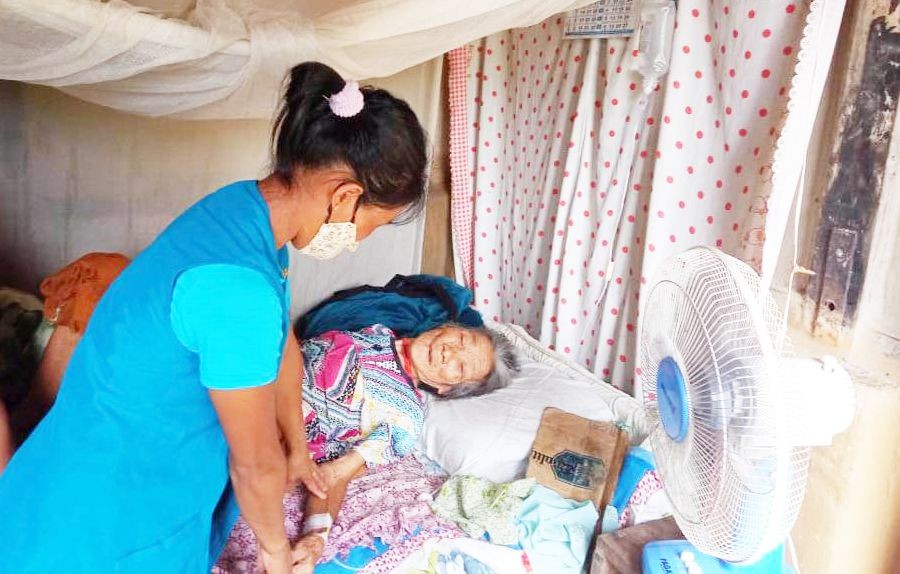Accredited Social Health Activists in Wokha district are tirelessly working to provide home based care, family planning counseling and distribution of ORS to beneficiaries during this pandemic. (Photo Courtesy: twitter@Chos_Rhts)

Our Correspondent
Kohima | August 21
The Nagaland Sustainable Development Goals (SDGs) Vision 2030 in its goal three on Good health and well being stated that by 2030, Nagaland will ensure healthy lives and promote well being of all ages by providing equitable, affordable and quality health care services to the people of the state.
It aim to reduce Maternal Mortality Rate (MMR) to less than 70 per 1,00,000 live births, end preventable deaths of new born and children under 5 years of age, reduce by one third premature mortality due to non-communicable diseases through prevention and treatment and promote mental health and well being, end the epidemic of HIV/AIDS, Tuberculosis, malaria and neglected tropical diseases and provide equitable and affordable and quality health care services to the people of the state.
Challenges
On health financing, the vision statement stated that norms for allocation of funds are based on population and not on requirements of gaps faced in certain locations among vulnerable populations.
“There is also a low utilization of funds due to delays in the releases of funds, difficulty in observing the complicated implementation guidelines and negligible private investors in health,” it stated.
It stated that there is adequate provision under the National Health Mission (NHM) to supplement Human Resources regiments. However, while majority of the doors, nurses and other technical manpower have availed the state quota/sponsorship to undergo their studies, only a few respond to contractual employment creating an apparent scarcity of technical manpower.
Traditional health providers function in parallel or sometimes in conflict with modern systems and there is lack of coordination/collaboration between the government agencies and such practitioners to support and promote indigenous system of medicines.
It stated that widespread absenteeism among medical staff is hindering factor to provide effective health care access to the people of the state.
In addition to lack of awareness and poor health seeking behavior, shortage of general facilities, poor communication and difficult terrain are factors contributing to lack of access to healthcare.
“Another reason for inaccessibility is poor referral transport network. This is mainly due to poor road connectivity, shortage of ambulances, lack of proper ambulance network management system and lack of skilled personnel in emergency care,” it stated. The vision statement also stated that consequent to financial constraints, there is a wide gap in terms of health infrastructure: hospital buildings and quarters, equipment, instruments, diagnostics and drugs, power supply, water supply, approach roads to hospital etc.
On the other hand, many assets are not being effectively utilized.
Strategies for success
The vision statement stressed the need for promotion of institutional deliveries and care around birth/respectful maternal care.
It also emphasized on the need to improve the quality of care in labour rooms and operation theatres, National Laqshya Certification is being implemented at district hospitals and other high case load facilities.
It aim to improve the quality of maternal and new born care during intra and immediate postpartum periods through providers who are competent and confident, Dakshata training’ will be expanded to all health care personnel involved in maternal and new born care.
Other areas include, operationalisation of High Dependency units at district hospitals and other high case of facilities, providing blood services along with appropriate skill HR for Caesarean Sections in all district hospitals and CHCs- First Referral Units, promoting institutional deliveries through Laqshya implementation and Dakshata training along with SBAS and to operationalize Sub Centres and Primary Health Centres to health and Wellness centre for delivery of comprehensive primary health care.
For home delivery, the state will ensure one auxiliary nurse midwife /General Nursing and Midwifery/Community Health Officers attend each delivery with use of misoprostol tablet and proper birth planning.
The state will saturate all facilities with Skilled Birth Attendance and Dakshata trained staff, line listing of all pregnant women by ASHAs, and consequent follow-up to ensure delivery.
The state will strengthen community death reporting through ASHAs and monthly review of all deaths (maternal and child deaths including stillbirths) will be done at facilities and at the district level.
State-level review meeting will be held under the principal secretary on quarterly basis and action points will be implemented accordingly.
The vision statement also emphasized on strengthening home based new born care for provision of essential new born care to all newborns up to 42 days of life including counseling of mothers on exclusive breastfeeding, appropriate infant and young child feeding practices and hygiene by ASHAs so as to ensure that there is a continuum of care from health facility to home during the most vulnerable period.
Follow up of new born discharged from the special new born care units is also to be undertaken by frontline workers through home visits.
The vision statement also emphasized on elimination of malaria by 2022.
On vaccination coverage, the vision statement called for ensuring all infants receive vaccines against seven vaccine preventable diseases (Tuberculosis, polio, diphtheria, pertussis, tetanus, measles and hepatitis B).
Current status of Nagaland
• Maternal Mortality Rate (MMR) per 1,00,000 live births is 97 compared with the national average of 122.
• Infant Mortality Rate (IMR) per 1,000 live births is 30 compared with the national average of 41.
• Under-five mortality rate (U5NR) per 1,000 live births is 37 compared with the national average of 50.
• Children immunization coverage stands at around 35.4 percent compared with national average of 62.0 percent.
• HIV prevalence rate of 0.76 percent among adults, third highest in the country as per the Nagaland State AIDS Control Society.
Focus for tomorrow
• Promote institutional deliveries, neonatal care and respectful maternity care and train health personnel for home delivery
• Ensure all infants receive vaccines against seven vaccine preventable diseases
• Strengthen Adolescent Health Services
• Universal Health coverage and aces to quality essential health care services
• Upgrade medical health centres and abilities/ faculties to national and international levels






